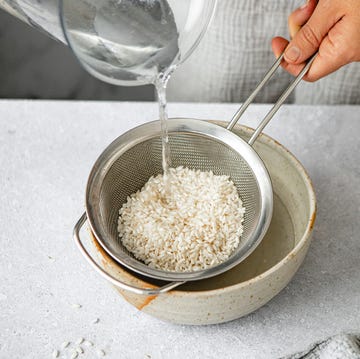It's cranberry season! Yes, in case you didn't know—cranberries do in fact have their own season and unlike strawberries or blueberries, these tangy red berries are typically harvested from September to November. (Note: That's why they're so popular around Thanksgiving.) But have you ever wondered where cranberries grow?
You may have seen those picturesque images of ruby red cranberries submerged in water. Or photos of farmer's wading in bogs and wearing coveralls and goulashes. But unlike popular belief, cranberries aren't actually grown in water. So, where do they come from? Bruce Langer, President at Langer Juice Company, provided some insight on how cranberries grow. And after working with hundreds of growers to source cranberries for their popular cranberry juice, they know a thing or two about the ins-and-outs of farming cranberries.
So, whether you're interested in bringing some Thanksgiving trivia to the table or you simply love making sweet-tart cranberry recipes, read on to learn about all things cranberry—including some fun facts about how many cranberries it takes to make a bottle of juice!
Where Do Cranberries Grow?
Cranberries in the United States grow in cool northern climates, but you'll also find them grown in parts of Canada. "Most of our cranberries grow in Wisconsin, which is the largest cranberry-producing state in the United States," Langer says. "Massachusetts, Oregon, and Washington also contribute significantly to our cranberry production as all of these regions provide the right climate and conditions for cultivating cranberries effectively."
Do Cranberries Grow in Water?
Surprise! Despite what it may look like, cranberries do not grow in water. Instead, they grow on low, trailing vines in dry bogs that are made of sandy, acidic soil. The planting season begins in the springtime when cranberries are planted with proper spacing to support growth. So, you might be wondering where the water aspect comes in.
How Are Cranberries Harvested?
When cranberries are ready to harvest in September, the bogs are flooded with water. And since cranberries contain little pockets of air, this allows the berries to float.
"This method, known as 'wet harvesting,' is not only efficient, but helps preserve the quality of the cranberries. The fall harvest aligns with the growing season (late September to mid-November), when cooler temperatures encourage the berries to develop their characteristic tartness," Langer explains.
Wet harvesting often produces berries that are used for juices, sauces, dried cranberries, and other cranberry products, but some cranberries are also harvested by dry harvesting. As the name implies, no flooding is used for this method and, instead, cranberries are picked dry off the vine. This process is used most often for those bags of fresh cranberries you might find in the produce aisle at the store.
Either way, the harvest also happens to coincide with "increased consumer demand for cranberries during the holiday season," Langer says. So, it's no wonder cranberry sauce has become a Thanksgiving tradition.
What Does "From Concentrate" Mean?
Deciding between cranberry juice and juice "from concentrate?" The two are more related than you might think. "The term 'concentrate' involves evaporating water from fresh-pressed fruits, typically involving a heating process. If a product is 'from concentrate,' that just means that the product has been made by extracting the juice from the fruit and then removing a significant amount of water to turn it into a concentrated form," Langer explains. "Juice from concentrate is more sustainable to ship, and the water is then added back into the juice concentrate before bottling."
How Many Cranberries Does it Take to Produce a Bottle of Cranberry Juice?
Fun fact: There are about 350 cranberries in a single bottle of Langer's Cranberry Cocktail! Though they process millions of pounds of cranberries each year, the focus on quality ensures that only the best cranberries make it into the bottle.

Kara Zauberman is the Senior Editor of Content Strategy at The Pioneer Woman, covering stories ranging from food, lifestyle, news, and more. When she’s not writing and editing, you can find her seeking out new restaurants or cooking for friends and family.















